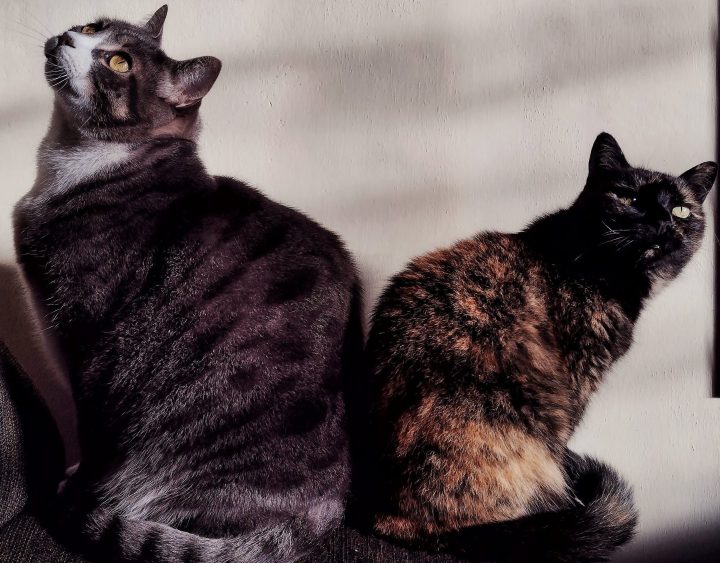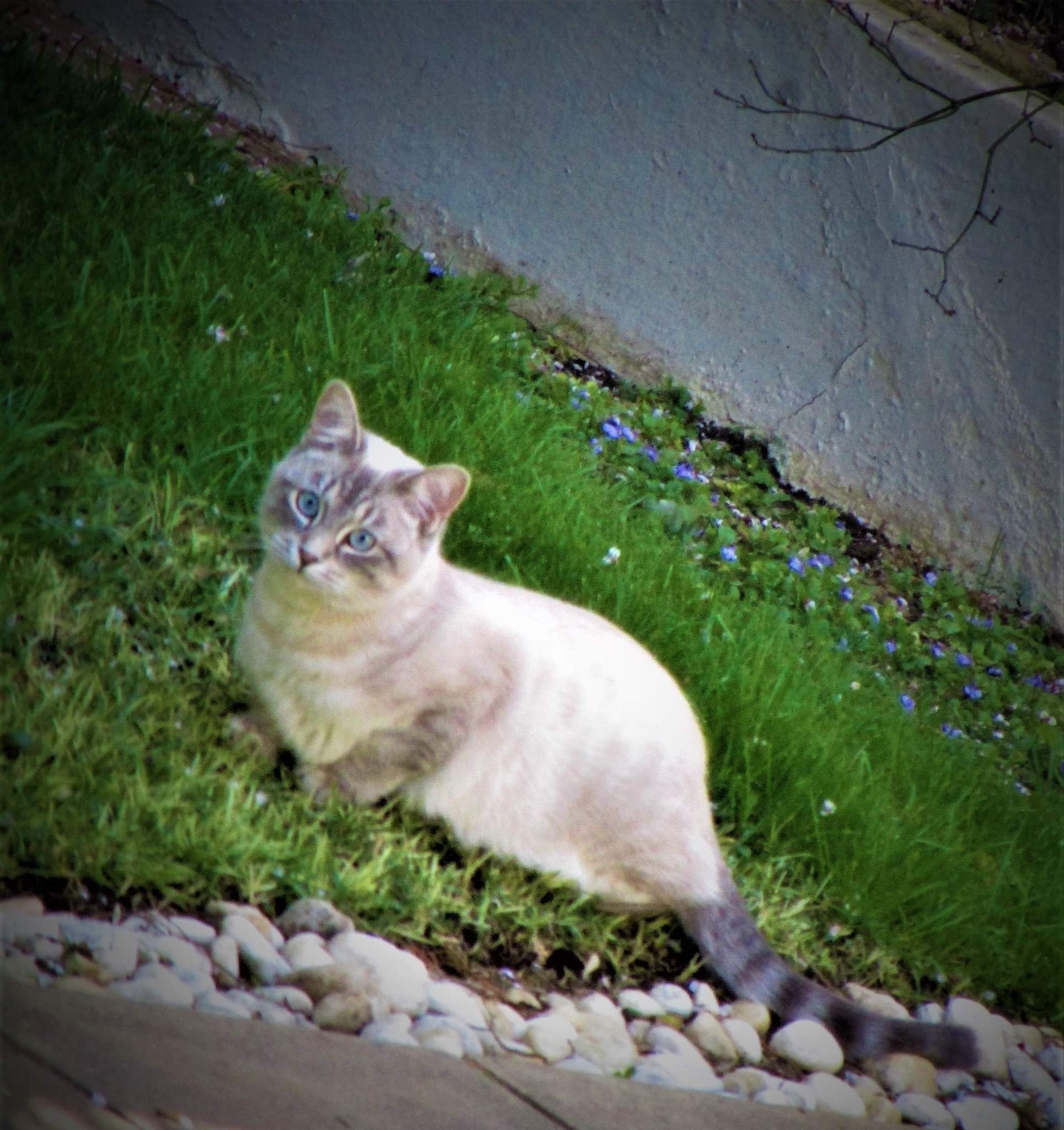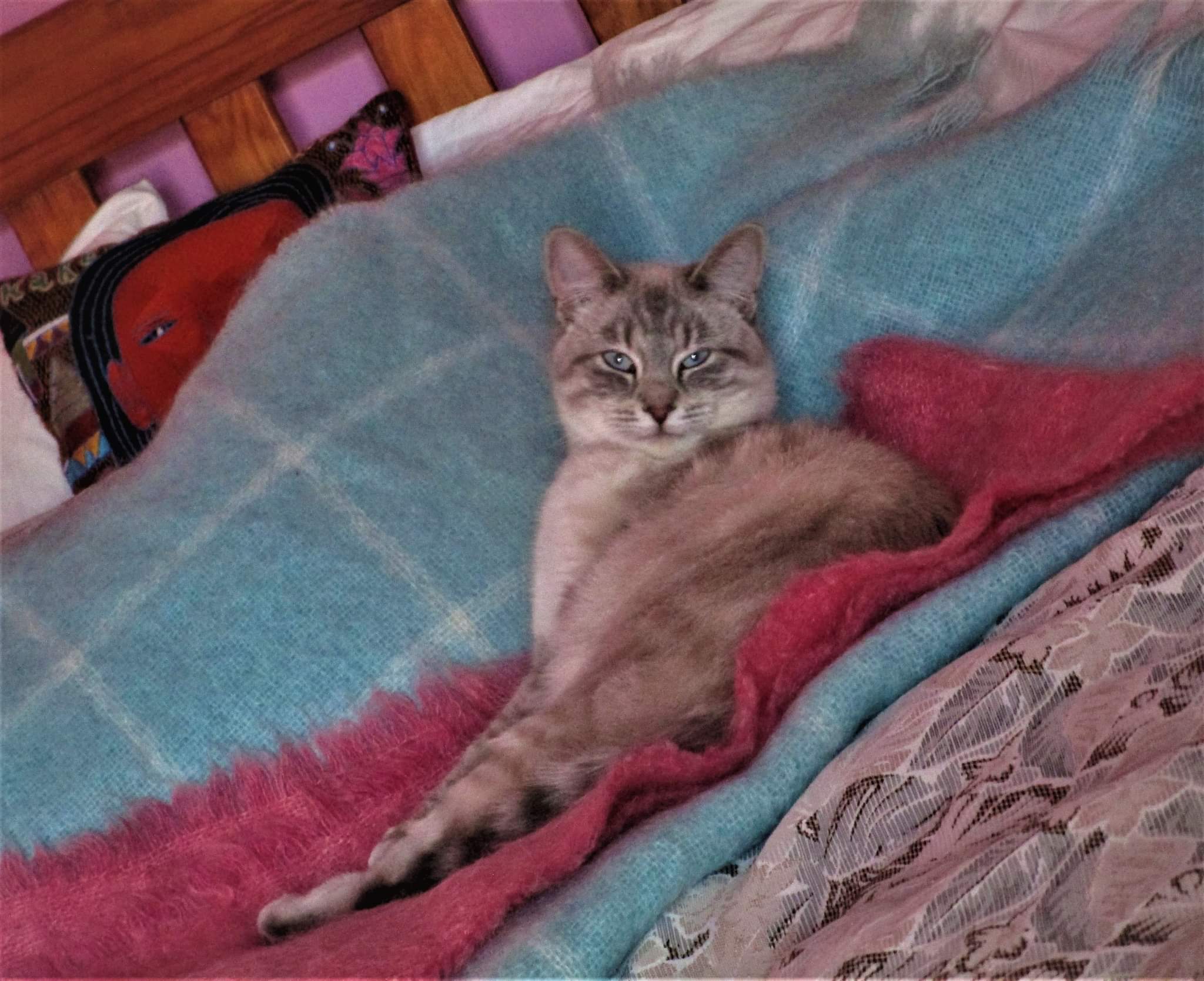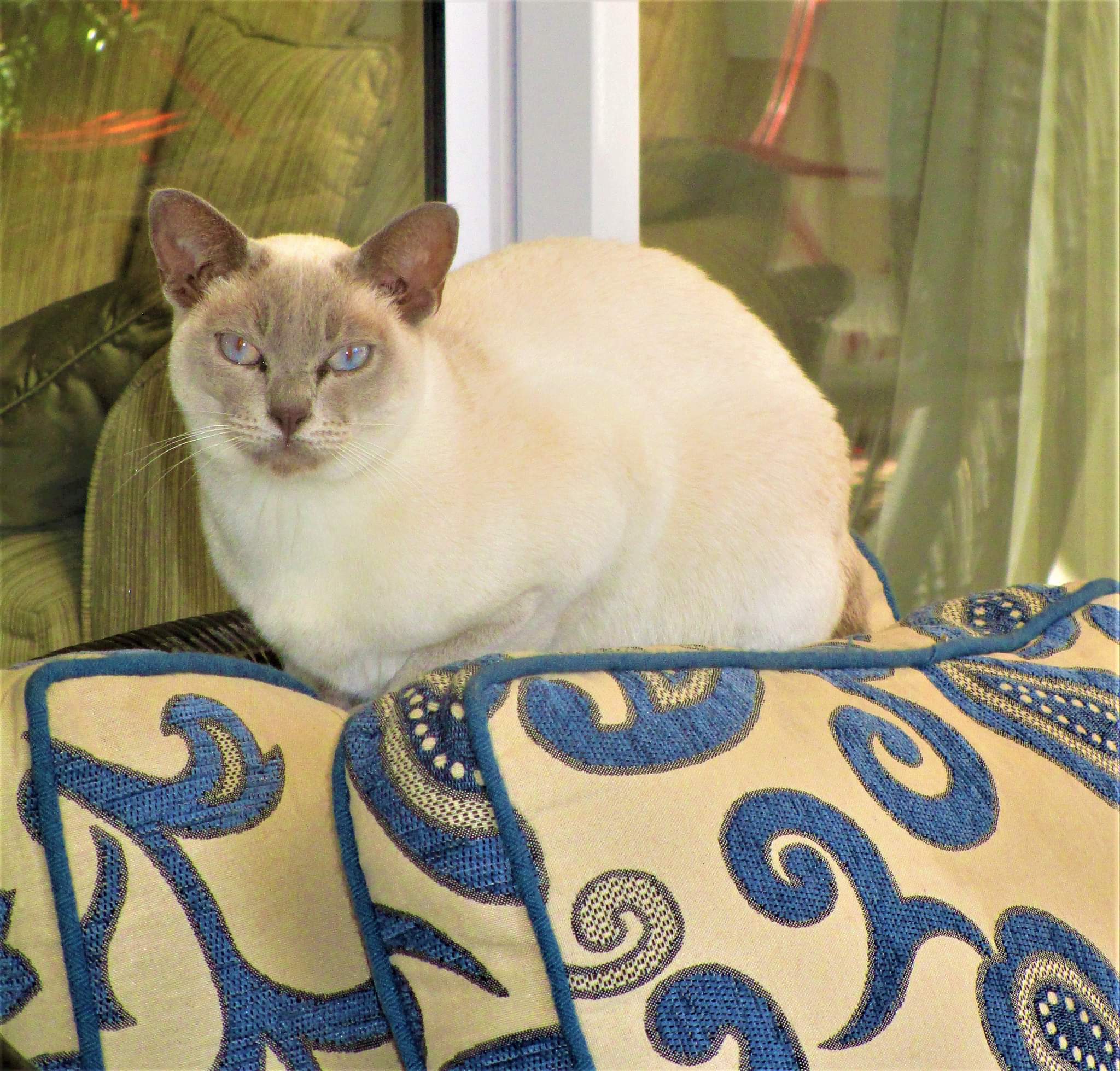FELINE MATTERS
The Cat Whisperer and I

True-blue cynics, we have gently put a paw forward into New Age thinking in order to lessen the chaos of our warring, two-cat household. World: Observe the battle between Lady Maya and Prince Loki.
For as long as I can remember, except during my teenage years when I was living in a small apartment, or when I was staying in a variety of temporary accommodations as a university student, I have always had pets around me. I liked the idea of sharing my life with animals.
In my early childhood, the first one I remember was a cocker spaniel, Black Doll VII, who was only briefly with us because it was quickly discovered she refused to allow any male — young or old — to go up the steps in our small, two-storey house. The bedrooms were upstairs, along with the house’s single bathroom, meaning her continued place in our family became very problematic. Thereafter, Bruno, a much mellower mongrel took her place, and he had no hangups about who used the stairs. Unfortunately, when we moved to a smaller, rented apartment (no dogs allowed, per the lease), Bruno was adopted by another family.
He had a bizarre craving — for a cat — of loving peeled melon skins.
In between, though, we had a constantly evolving menagerie of reptiles, amphibians, and fish in the house’s tiny basement, in the space between the stairs and the house’s furnace. We housed this collection in various glass tanks and we worked constantly to provide the correct foods and climate controls for these creatures.
The hognose snake only ate baby toads (live if possible); the zebrafish and neon tetras needed a slightly salty, carefully controlled pH in their water; the horned lizards needed heat-lamp warmth and wriggling beetle larvae, and the iguana also needed warmth as well as a daily supply of fresh fruit. Meanwhile, the box tortoise ate lettuce and other vegetables left on a plate on the kitchen floor. He had free range in the house, but his favourite spot was under the legs of the piano bench. Sadly, the menagerie had to be disbanded because of our move to that apartment.
Years later, after we had joined the foreign service and began to be assigned to postings abroad or back in the US on occasion, the old urge to have a pet or two returned. In 1975, in Johannesburg, we adopted a loving, all-black kitten and mischievously named him Treurnicht in honour of a certain odious politician. Every afternoon he would perch atop the door of the house’s gate to await my return from work. Then he would jump down the wall, never quite avoiding scrapping his chin on the veranda, thus giving him a slightly shaven look at the bottom of his jaw. In mid-June 1976, he was rechristened Amandla.
Moving back to the US, he was handed off to friends in South Africa, but we learned he had lived a long and happy life, even without us. Then in Washington, we adopted a Manx kitten, which we also named Amandla. He had a bizarre craving — for a cat — of loving peeled melon skins, and Amandla II was a cuddly creature who revelled in getting attention.
When we moved on to Indonesia, we were suddenly stymied by the airline, which had imposed a mysterious embargo on shipping pets that year, and so my mother inherited Amandla and he took to an idyllic life in Cape Cod, Massachusetts. He learned how to signal the end of his field and stream gambols by ringing a bell set about 50cm above the ground, so that the kitchen door could be opened for him.
Meanwhile, in Indonesia, our garden quickly became host to several cats, although they stayed with the house when we left. Then in Japan, in response to the pleadings of our young children, we embraced a grey kitten, Fluffluff. A pure Persian, she moved with us to Swaziland (now Eswatini) where she ruled a small hillside, but resolutely refused to have anything to do with the only other purebred Persian in the kingdom.
Fluffluff was eventually joined by Socks, a gentle, mixed-breed dog. Fluffluff and Socks easily embraced Oliver as well, a stray cat who just came along to stay, although the two cats mysteriously vanished just as the movers were packing up our belongings for a return to Washington, DC. Socks, however, found a home with a German family who even added a small terrier to their family in order to keep Socks company as he aged.
Now back in the US, we went in search of a new cat; this time the choice was a Somali. In Chantilly, Virginia, we found our Chantilly (and not from the Elvis song), who moved with us to Tokyo and then Johannesburg before dying at the age of 16.
But we filled that sad void with a gentle black and white striped and spotted kitten, Kaori (meaning “fragrance” in Japanese) who was brought to us from Durban by one daughter. Kaori was eventually joined by yet another Somali, a haughty male, incongruously named Koko (after the famous gorilla who had adopted the kitten or perhaps for Coco Chanel, family lore varies on this).
In the end, after 15 years, Koko came down with feline diabetes and we were required to inject him twice daily with insulin (you must try that as a test of your agility) until he died from the complications of a stroke. Astonishingly, a few days later, Kaori suddenly also crossed the rainbow bridge as well. We didn’t realise until then how closely they had bonded. Their ashes now repose, side by side, beneath two trees in the garden they had favoured as blinds for catching unsuspecting birds.
This brings us to today’s lesson…
And so this recitation of the history of our human-animal interactions brings us to today’s lesson.
After several months of mourning Kaori and Koko’s near-simultaneous deaths, we resolved that this time around, we would adopt rescued animals. There are so many these days, the stories and pictures on social media are so plaintive, and they all deserve homes.
Our first foray into this new land was a purebred, lilac point Tonkinese, named Lady Maya, who had been kept far too busy as breeding stock, very sadly, in a commercial cattery. Her visage in an electronic advertisement for rehoming was so mournful that we fell in love with her immediately, despite the tale of her traumatic life. She was not the most affectionate creature we had ever encountered in our experience with pets, but we sensed she sorely needed real companionship — human and feline.
Later, when we saw another rescue cat advertisement, this time for Loki, a not quite purebred of the same basic type, we said, “Of course.” He was so affectionate, we could not refuse him. How does one ignore a kitten that leaps right on to your lap without coaxing, and then begins to purr passionately, fervently? Loki had come from a home where the couple had just been divorced and neither was willing to take Loki because he would remind them of their failed marriage.
There was desperate howling, hissing, scratching, chasing under beds and chairs, followed by the inevitable sumo match to the death between two cats.
In this first part of the introduction process, Lady Maya was given the run of the house and its garden and Loki was placed in a bedroom for a few days to give him a chance to settle into things. He was given access to another small garden, but one that had bird feeders and a fish pond. The plan was we would gradually introduce them under controlled conditions and it would be just like in the movies. Immediate friendship and love.

Loki sits on the grass, awaiting an innocent pigeon trying to land on the green patch. Image: Supplied

Loki enjoys the warmth of blue and pink mohair blankets. Image: Supplied

Loki sleeping. Image: Supplied
However, those controlled conditions quickly devolved into a fur flying, howling, screaming donnybrook when the new side of Lady Maya’s personality was revealed — a seemingly felinocidal one. She seemed to be saying, “This is my house; you don’t belong here; I will ensure you are gone by any means necessary. You will not be assimilated into my world.”

Sitting on cushions, Lady Maya surveys her realm but gives no sign of her felinocidal inclinations. Image: Supplied
Okay then, so we put Lady Maya in the front bedroom and lounge with access to the small garden and fish pond, while Loki was on the other side of a closed door with access to the kitchen, the study, and the larger garden. No fish, but there were bird feeders to attract birds for the edification of any cat. Several subsequent encounters following the first traumatic one produced the same result. There was desperate howling, hissing, scratching, chasing under beds and chairs, followed by the inevitable sumo match to the death between two cats.
Things could not go on like this. The internet offers clues, YouTube talks and references to further information for pet rearing, but no easy solutions. We asked veterinarians and other pet lovers what they recommended. Eventually, we received the name and phone number of a genuine cat whisperer. Don’t laugh. Read on.
The cat whisperer
How many readers have seen the film The Horse Whisperer, or are among the 15 million or so people who bought the novel it was based on? Yes, of course, some people watched that film for glimpses of Robert Redford and a young Scarlett Johansson — but the poignant story and all that Rocky Mountain scenery were also a magnet.
Yes, this career actually does exist for horses — and cats and dogs. There are people who seem to have a preternatural way of connecting with the soul of an animal and sussing out the animal’s fears, stresses, and emotional pressures, and then finding a pathway towards healing the troubled soul of the beast.
Of course, we all know about people who bond closely with their pets, or, even more so with working animals such as shepherding dogs, guide dogs, or emotional support animals. In the news recently, there has even been a profile of a man who has bonded with minks so that they can remove muskrats and other pests from drainage canals and riverine parklands. But the idea a human can somehow reach across the gap between human and animal to help an animal heal psychologically seems a stretch (at least to me). Mainline psychiatry, after all, presupposes talking through one’s problems and life challenges — and, of course, neither Black Doll VII (our earlier cocker spaniel) or Lady Maya could tell us what their problems were, nor could we guide the animals towards more effective ways of problem-solving in their lives, could we?
Nevertheless, because of the battleground we have been living in, with some reluctance and a less than total belief in the idea of a whisperer, we summon the cat whisperer. We don’t have much choice since our house divided increasingly cannot stand. (With apologies to Abraham Lincoln.)
Even before she arrives, she advises us to take time with each cat separately and speak with them frankly about the problem. Explain it to them, and ask gently but firmly, “Can’t we all just get along?” And so we do so. At length. We feel a bit foolish, but what the heck. The conversation is necessarily one-sided, but for some reason, both cats look up at us with their beautiful ice-blue eyes, almost as if to say, “Well, yes, I’m willing to do that, but that other cat is the real problem. You just can’t talk sense into some creatures.” Are we entering a Tom & Jerry cartoon?
At the precise time of our appointment on a Saturday afternoon, in walks our cat whisperer. It turns out she is not exactly a weird, visitor from some distant astral plane… Instead, she has had a career as an ecologist with national parks, and she came to this path from dealing with her own pets’ challenges.
She sits down and talks with Lady Maya as one would with a recalcitrant teenager, sulking in his/her bedroom with the earbuds affixed and the sound at maximum. She adds to the conversation the irresistible temptation (for a cat) of a flexible stick with some thin rope fibres at the end of it.
She explains to Lady Maya the need for her to grow up and take on the responsibility of training Loki to become a responsible adult cat. While this conversation is taking place, the cat whisperer begins to engage in something called the Tellington Touch, a movement that describes drawing repeated circles on the cat’s body with a finger. It is less than a massage, but more than a pat.
And then she moves on to Loki (securely in the other room, of course), encouraging him to embrace our other cat as a natural leader and to learn from Lady Maya’s guidance in all things feline.
Both my wife and I take turns, now, making the same circles on the cats’ bodies and offering reassuring conversation. Amazingly, they both are calmer from this encounter.
After our session, we talk with the cat whisperer to discover that her technique — first described by the Canadian-born horse trainer Linda Tellington-Jones — seems to owe much to the influence of pioneering psychological studies by Ivan Pavlov and BF Skinner in developing techniques of conditioning — those bells and rewards for doing what the trainer wants the animal to learn, broken up into small steps and more easily accepted behavioural changes.
Yes, there is a layer of mainstream operant conditioning in all this, but there is also the idea of engaging verbally with the animals and listening to (or sensing carefully) the non-verbal cues from animals of what they need, sort of like a real-life Dr Dolittle but without Rex Harrison.
By now, we are reading about all the non-verbal cues cats give us when they carry their tails erectly or bite their owner’s hand gently, or all the other things that can seem mystifying to humans, even as we try to sense changes in behaviour in our two felines from their daily doses of the TTouch.
The Tellington TTouch website describes it this way: “It includes both bodywork and movement exercises that positively influence behaviour, performance, co-ordination, balance and well-being, while deepening understanding and the relationship between humans and animals. These, non-invasive touches & exercises influence habitual patterns of tension and posture by giving new information to the nervous system. As a result, animals relax and learn to make better choices.
“Developed by internationally known animal expert, Linda Tellington-Jones, TTouch is based on cooperation and understanding rather than dominance. These revolutionary techniques promote optimal performance and health without fear or force. TTouch ™ — the Tellington-Touch — is a method based on circular movements of the fingers and hands all over the body. The intent of the TTouch is to activate the function of the cells and awaken cellular intelligence — a little like turning on the electric lights of the body.’ ” Not too New Age, is it?
Well, okay. Maybe this has something in common with traditional Asian- style healing massage therapy that connects to those magical meridians in the body — something that does work (so my back tells me), even if the physiological explanation for it remains unclear.
Our next step is now to try to reintroduce the two cats — in very carefully controlled conditions, with one on a lead or held snugly perhaps — to see if they can coexist. Hold thumbs for us.
As insurance, however, we have installed an electric pheromone dispenser in the kitchen and have just bought a pheromone collar for Lady Maya, as well as packets of something called Rescue Remedy for adding to their drinking water. Anything so we can announce, “Peace is at hand.”
Otherwise, the cat whisperer will have to pay another visit to our house, now organised with its feline-style Berlin Wall, in order to guide us in further, more advanced methods. One thing we have decided, however, is that we are not going to rehome Lady Maya or Loki onward.
In their previous situations, they had already endured enough — and it is our task to bring about a calmer modus vivendi with these two cats as willing participants. This will be the case even if we have to learn to speak Miaowish to make things clearer to them both. Keep us in your thoughts and prayers as we work to make this pair “learn to just get along”. DM/ML
In case you missed it, also read The cats I’ve loved and lost
Visit Daily Maverick’s home page for more news, analysis and investigations

















 Become an Insider
Become an Insider
Oh how I relate. Beautiful story!